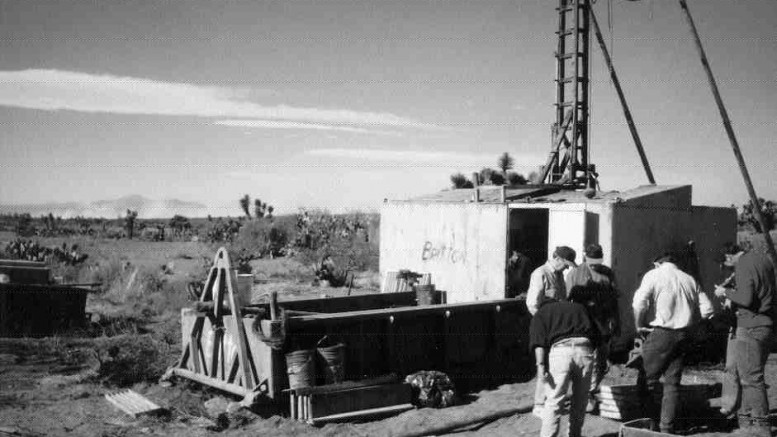Vancouver — With the San Nicholas project on simmer, owing to low zinc prices,
Covering 32.5 sq km in the historical Concepcion del Oro district, Penasquito hosts a 9-sq.-km mineralizing system that lies 30 metres below alluvial cover. Kennecott, a subsidiary of mining giant
Western Copper entered the picture in 1998 by acquiring the property as part of a deal that included eight projects scattered throughout Zacatecas, San Luis Potosi and Guanajuato states. The Dale Corman-led junior subsequently drilled nine holes before dealing the property to Lima, Peru-based Mauricio Hochschild & Cia in August 2000.
In April, Western Copper reacquired its 100% stake in the project after Hochschild dropped its option to earn 68%.
“Hochschild did a great job in enhancing the project, but they were not looking for a large, bulk-tonnage target,” says Western Copper President Thomas Patton. “At the end of the day, it just didn’t fit with their objectives.”
The Peruvian company had spent more than US$1 million on exploration, mostly at the Chile Colorado prospect, where 11 core holes were drilled. As a result, silver-lead-zinc mineralization was delineated over an area measuring 500 by 350 metres and to a depth of 300 metres. The weighted average of the mineralized intervals from 19 holes drilled at Chile Colorado by Kennecott, Western Copper and Hochschild is 0.54 gram gold and 100 grams silver per tonne, plus 0.8% lead and 1.8% zinc. Based on the results, a preliminary economic evaluation using a 20,000-tonne-per-day operation over a 14-year mine life generates a positive internal rate of return at prices of US$4.50 per oz. silver, US$280 per oz. gold, US45 per lb. zinc and US22 per lb. lead.
“We believe silver has a significant upside,” says Patton, “and Penasquito has a significant silver component.”
Chimney-style
Recent data suggest the zone may mark the southern lobe of a much larger system that extends north for 1,200 metres. Also of interest are the two breccia pipes, which have been tested by 35 holes. The Outcrop pipe has returned selected values of 6.8% zinc, 7.4% lead, 4.02 grams gold and 885 grams silver over 10.4 metres beginning at a depth of 333 metres, as well as 170 metres averaging 2.13% zinc, 0.87% lead. 0.2 gram gold and 60 grams silver starting at depth of 463 metres. The Azul pipe is highlighted by 295 metres averaging 1.1% zinc, 0.87% lead. 0.38 gram gold and 66 grams silver, beginning at a depth of 142 metres. This hole tested only a small portion of a 600-by-200 metre intrusive contact zone. Also, several of the anomalies defined have the same shape as Chile Colorado, suggesting the presence of additional “chimney-style” base metal mineralization.
“A minable zone could start at Chile Colorado, move through the breccia pipe and come out on the north side,” states Patton. “This would dramatically ramp up the bulk-tonnage potential.”
Having acquired complete ownership and determined that the mineralized zone at Chile Colorado is open in all directions, Western Copper hired Kilborn Engineering to evaluate the project’s economic potential. Initially, the evaluation will entail a 6,875-metre drill program so that mineralization in the Chile Colorado zone can be upgraded to the inferred, and finally reserve, category.
“We plan on drilling off at 100-metre centres and then infill as needed from there,” says Patton, who envisages Chile Colorado as one of the largest and lowest-cost silver deposits in the Americas. “The whole Penasquito project has good metallurgy and infrastructure, and I believe we are not far from having a viable mine.”
The cost of completing a feasibility study is pegged at $2 million.
San Nicolas
Meanwhile, south of Penasquito,
Metallurgical tests were recently completed, and the company expects to have finished much of the feasibility study by year-end. However, with a resource of 75 million tonnes grading 1.4% copper and 2.1% zinc, the project may not arrive at the economic threshold set by the newly merged company.
“We have a large land position in the area and are seeking a higher-grade deposit that could push the project over the top,” says David Moore of Teck’s newly formed exploration business development department.
Discovered in 1997, San Nicholas is one of a handful of non-operating properties in which the major will reduce the carrying value held on its books for the third quarter of this year.
Teck Cominco holds a 74% interest in the project, with the remainder held by Western Copper. The major can boost its interest to 81% by funding development costs.


Be the first to comment on "Western Copper flies solo at Penasquito silver project"